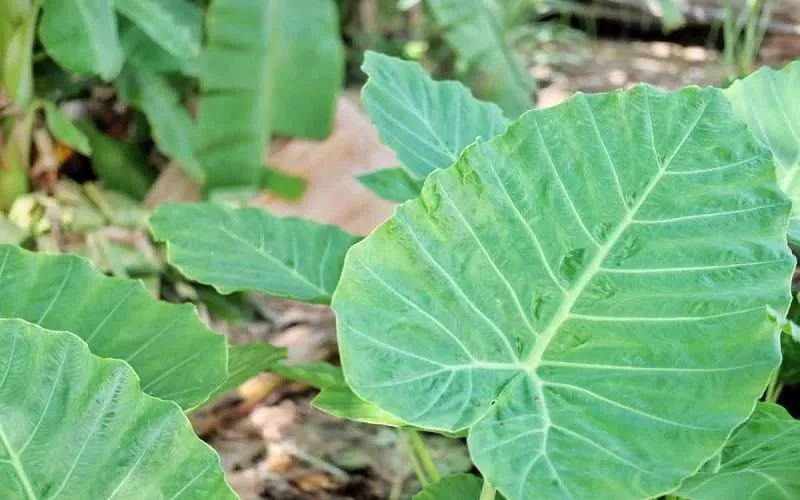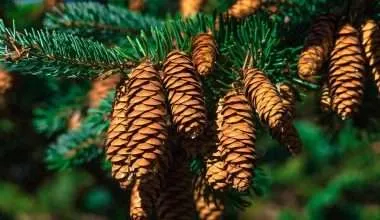Table of Contents Show
Want your garden to look extra attractive this summer? Grow some elephant ears! A tropical plant with heart-shaped foliage and curved edges is a treat for any garden. The elephant ears add personality to any landscape. The appearance is true to its name. It has glossy and lush green leaves that look like elephant ears.
Read on to discover more about these magnificent plants, how to care for them, and innovative ways to make them a part of your home.
What Is The Elephant Ear Plant?
Elephant ears are tropical plants typically found in regions with a humid and warm climate. They are great for providing shade as they can grow up to six feet tall, with their leaves stretching to the size of your arm.
The foliage colors range from yellowish-green to black. Most gardeners store the bulbs inside during winter as these plants cannot withstand cold weather.
Elephant ears love heat and humidity. You can use them as indoor plants to improve interior aesthetics.
They can stay happy as solo plants or with other summer/annual bulbs. Most elephant ears species have no particular fragrance.
Parts Of An Elephant Ear Plant
The sharp and arrow-like leaves of elephant ears are their most prominent feature. Their veins are highlighted and give them a beautiful shape.
The spathe is the structure on which flowers are produced. The long sheaths and stalks give support to the plant to stay put. The corm is the stem of the plant that stores food. Lastly, the roots of the plant absorb minerals and water. Additionally, it is attractive because it has enormous leaves.
Types/ Varieties Of An Elephant Ear Plant
Since the Elephant Ear has diverse varieties, it can be hard to take your pick, especially if someone is new to gardening.
To begin with, think about your purpose for growing these striking plants. Do you want to use them as a statement to adorn your home or garden? Or do you want to fill a huge vacant space in your garden?
Although the possibilities are endless, your answer will help you choose the suitable Elephant Ear. They also come in different colors so you can see which varieties will complement your garden or your indoor space.
You can usually categorize them under four species; Alocasia, Colocasia, Caladium, and Xanthosoma. They are all part of the Araceae family.
1. Alocasia
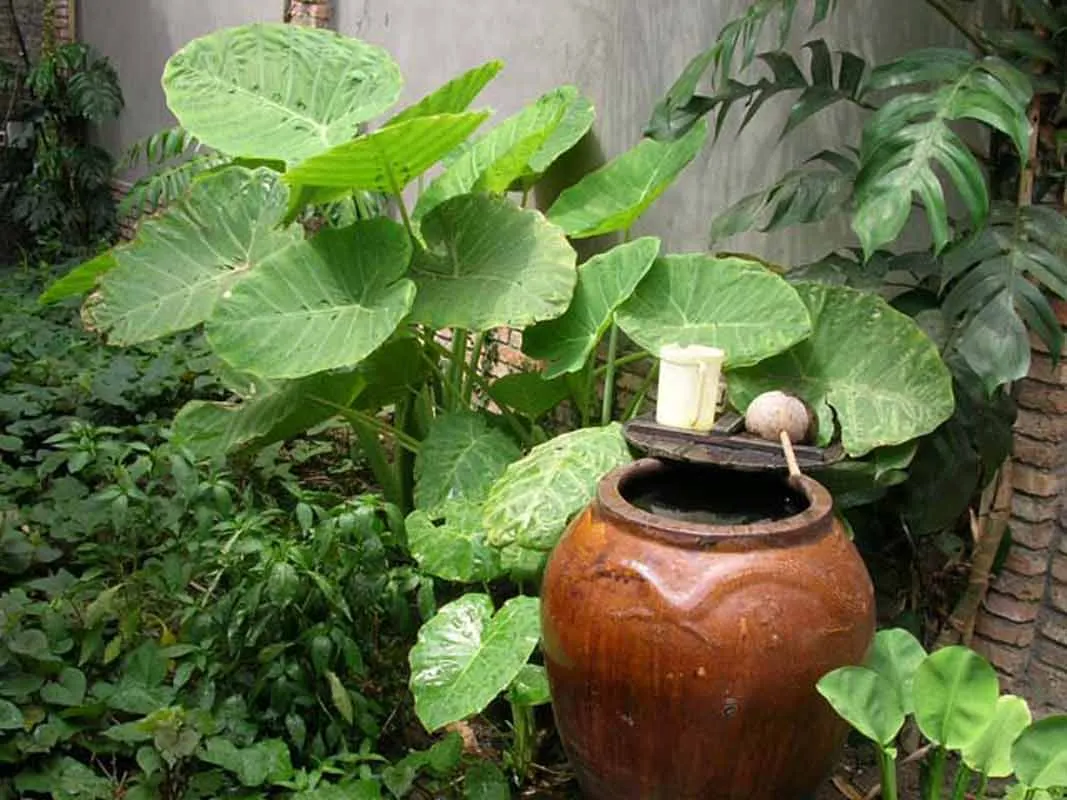
One way to identify an Alocasia is by its heart-shaped leaves. The leaf’s tip should either point upwards to the sky (at a right angle to the stem) or travel outwards. Alocasias have luscious green and shiny leaves or contrasting veining.
They are usually smaller than colocasia and perfect to be kept in containers and smaller gardens. They don’t grow well in direct sunlight and prefer partial shade.
Experienced gardeners grow them in well-drained, rich soil. However, excessive moisture can hinder their growth.
Alocasias can grow flowers of aroid type with a white or green border surrounding a cream or white-colored petal-like collar. Fruits such as globular berries with many seeds are common on alocasias. However, alocasias rarely produce fruits when kept indoors.
2. Colocasia
The distinguishing characteristic of Colocasia is the downwards-pointing tips of its leaves. These plants grow well in wet soil because they love moisture. There is less chance of overwatering them. Unlike alocasias, they can accept direct sunlight.
Their foliage can get even large when they are kept outdoors under full sun along with lawn care. Their size depends on the amount of water and sunlight they receive.
If you have a small Colocasia, grow it in a pot or a container, and adjust it according to its needs.
A large container might still be a better option so that it can expand with ease.
Colocasia esculenta species is widely popular in Asia, where it is called taro. The tubers of the plant have been cultivated for centuries for culinary purposes. Fields of Colocasia esculenta can be found in Hawaii, where they are known as poi.
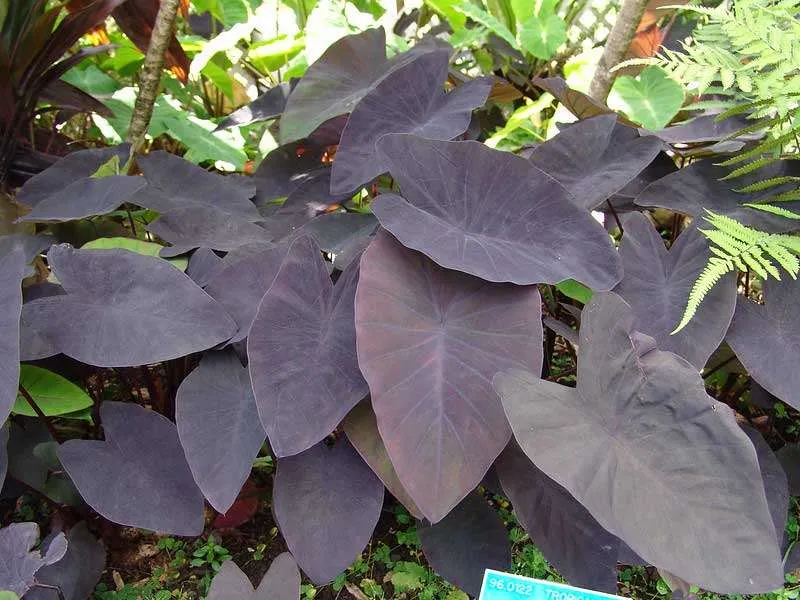
3. Caladium
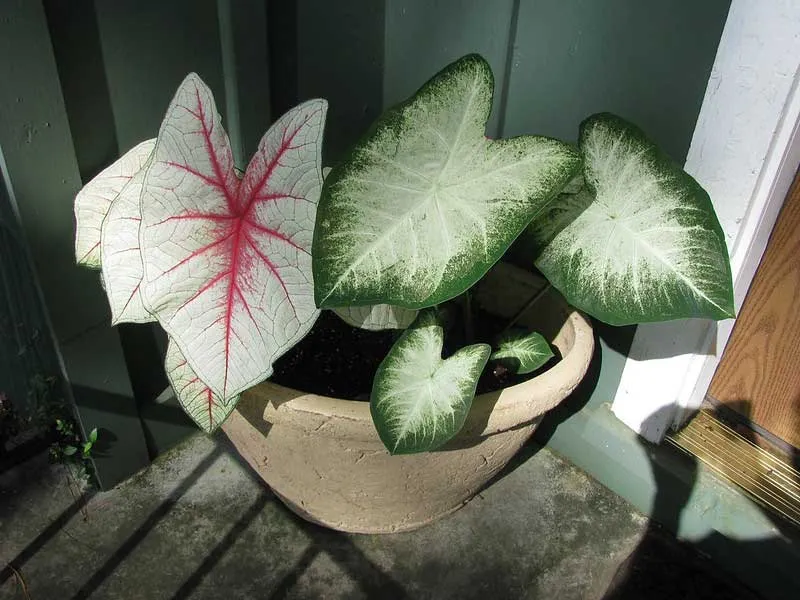
These are often called angel wings due to their small and glorious leaves. They are perfect for growing indoors or in small gardens.
The foliage ranges from different shades of green, white, and even pink or red. They require moist soil to grow to their maximum capacity.
They can grow up to 3 feet tall and spread over 2 feet. Most Caladium varieties tolerate early morning sun. However, the best way to keep them is in partial or complete shade.
Keeping them in direct sunlight can make them look dull. You should raise Caladiums at a distance of eight to twelve inches and cover with one inch of soil. They are summer plants and should not be kept outdoors in winter.
Humidity and heat can do wonders for Caladiums, as they will reveal their bright-colored leaves. You can put small caladiums in pots and display them to make any space in your home livelier.
4. Xanthosoma
Similar to other species of elephant ears, Xanthosoma also prefers humid and warm weather. These are not as common as others in home gardens. Like alocasias, they are not shield-shaped and are held upright.
They require partial or complete shade to grow properly. They can grow up to 4 feet tall and spread over 1 to 4 feet. An organically rich and moist soil would work well for this elephant ear, but make sure it is well-drained.
They grow from bulbs but cannot be identified as true bulbs themselves. The bulbs have rough ridges with brown skin along with a pink or white interior. Some types of Xanthosoma produce slender, long stems. However, it varies for every plant.
Some of these produce tubers, which grow on the sides of the main bulbs. Their tubers are edible, just like Colocasia.
How To Care For The Elephant Ear Plant?
The care would depend on the elephant ear type, location, and climate. You can adjust these general tips and the essential elements according to your environment.
1. Soil and Moisture
Most elephant ears require organically rich soil that is well-drained and moist. However, the soil should not be saturated.
Most of the species do not grow well in wet conditions, except Colocasia which can tolerate different levels of moisture. Therefore, You can often come across Colocasia in tropical water gardens with towering green leaves. The other elephant ears will become drooping and dry if exposed to too much moisture.
2. Watering
Use room temperature water that is pH balanced to protect your plant’s health. You can either choose to make the soil less draining or water your elephant ear more often. Always check the soil before watering because you do not want to overwater or underwater.
They are sensitive to root rot as they have a bulb underneath the soil. You can water them early in the day so they are dry at night to avoid diseases. Water the root zone and not the leaves because the leaves can get damaged from too much water. You don’t have to water elephant ears frequently.
3. Fertilizer
For fertilizers, less is more. Most elephant ears do not need heavy fertilizers. Use a slow-release fertilizer while planting. Follow the directions on the package. Use a diluted amount and fertilize when you notice a growth or at every other watering session.
Furthermore, pay close attention to the plant. Yellowing leaves are a sign of micronutrient deficiency. Apply a micronutrient-rich fertilizer to prevent any such shortage. You may also spray Epsom salts on the base of your elephant ear plants every month.
4. Exposure
Most elephant ear plants prefer shade or filtered sun, but some can grow well in direct sunlight. The greener the plant, the more sun it would need. The ones with darker leaves require less sun.
So, make sure of your selected species before deciding on its location. They also work well at room temperature. Most elephant ears thrive in humid weather, particularly when humidity levels surpass 55%.
5. Pests
Spider mites can use some of these plants as breeding grounds. Therefore, it is helpful to keep them clean. When you water them, spray some neem solution to prevent foliage damage.
Moreover, you can also mix rubbing alcohol with water and apply it with a brush to deep clean them. Adequate moisture levels also keep off pests.
Where to Plant?
1. Decks and Patios
Elephant ears are a great addition to shady porches, decks, and any other part of your house that does not receive direct sunlight. They also add a tropical charm to spas, water gardens, and pools.
2. Entryways
First impressions matter. Elephant ears can add a wow factor to a front door entrance. Place them there in large containers or pots.
3. Fences and Walls
Planting them near a fence or a wall prevents the plants from excessive exposure to the wind and sun. Their big leaves have another surprising advantage. Use them as decoration pieces for blank walls.
4. Yards
You can benefit from the enormous leaves of the plant to make an area more private. Raise them along outdoor areas to hide the view or highlight a space.
Keeping An Elephant Ear Plant Indoors
Elephant ears can add an attractive element to your home or any indoor space. Most of these plants can be kept inside, especially the ones facing upwards. Just make sure they have enough water and light according to their needs.
They usually come out in late spring or early summer when planted outdoors. However, many gardeners keep them indoors to start the planting process early. The general rule is to bed them six weeks before the last frost (if it snows where you live).
Grow them in pots that can accommodate the bulbs’ size and are about an inch deep. Make sure you are using good-quality soil for potting. Use a heated mat underneath your pot or containers to replicate tropical conditions.
This method would make the plants emerge sooner. They can get heavy and enormous, so make sure your pot is big enough with a sturdy foundation to support their growth. The roots should also have space to grow in the container.
You can water your plants every week to keep the soil moist. If you don’t have a humidifier at home, you can mist them on alternative days to keep the plants humid.
You can trim the leaves if they begin to wilt or get discolored. You can clip the discolored leaves following the natural shape and lines. Furthermore, remove dust from leaves regularly so they can absorb light better. Use a damp cloth to clean the leaves.
Benefits Of An Elephant Ear Plant
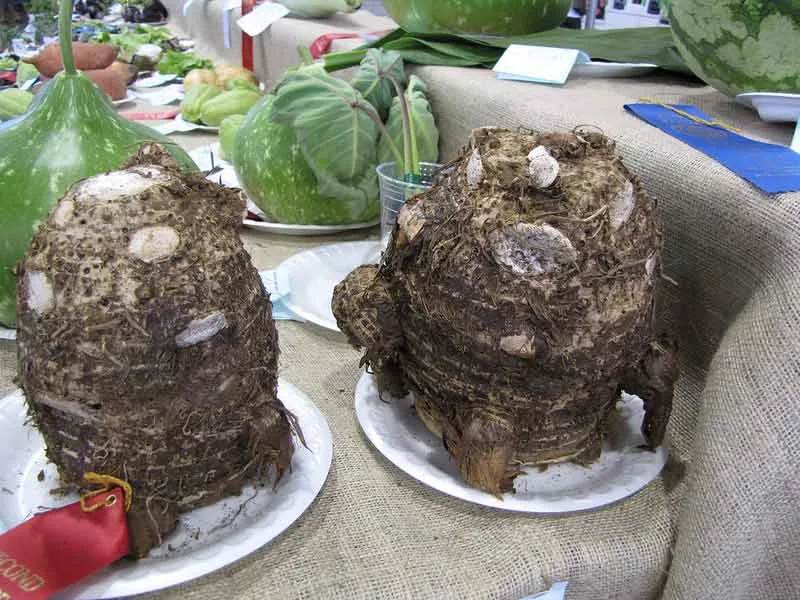
The corms are the edible part of the Colocasia esculenta, used in various Asian cuisines. The plant grows in tropical regions of Asia, where it has been a primary staple food for centuries, particularly in New Zealand, Indonesia, and Hawaii.
The ancestors of Hawaiians used various parts of the plant to treat ailments, including diarrhea, skin disorders, asthma, neurological disorders, and asthma. Also, the juice of the corm treats baldness and body pains.
Additionally, the roots of Colocasia esculenta are rich in fibers and micronutrients and low in calories. Therefore, they have multiple health benefits, such as weight loss and the prevention of heart disease. Some states of the USA categorize them as food products.
The corms are thinly sliced and cooked at high temperatures in oil for food that resembles potato chips. Moreover, Taro or arvi vegetable is cooked in Southeast Asian houses and is similar to a potato in taste.
Is Elephant Ear Plant Poisonous?
Many countries use the leaves and roots of the plant for food and medicinal purposes. However, most parts of the elephant ear are poisonous and have toxic properties. Nobody should consume them without proper cooking.
The leaves contain calcium oxalate crystals and gastroenteric irritants. Moreover,their juice can cause dermatitis and allergies to sensitive skin and mouth or throat inflammation. Wear gloves while you take care of the plant. And wash your hands thoroughly after you have finished.
Taking care of elephant ears is not an easy task. Some enthusiasts even call them the ‘drama queens of the garden’. Despite that, we hope this article encourages you to make these attractive houseplants a part of your home.
